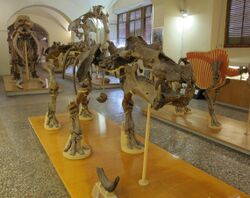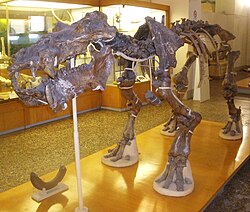Biology:Hippopotamus antiquus
| Hippopotamus antiquus | |
|---|---|

| |
| Hippopotamus antiquus in Florence Palaeontology museum | |
| Scientific classification | |
| Domain: | Eukaryota |
| Kingdom: | Animalia |
| Phylum: | Chordata |
| Class: | Mammalia |
| Order: | Artiodactyla |
| Family: | Hippopotamidae |
| Genus: | Hippopotamus |
| Species: | †H. antiquus
|
| Binomial name | |
| †Hippopotamus antiquus Desmarest 1822[1]
| |
| Synonyms | |
| |
Hippopotamus antiquus is an extinct species of Hippopotamus that ranged across Europe during the Early and Middle Pleistocene.
Chronology
H. antiquus is suggested to be closely related to the African species Hippopotamus gorgops, and may be a descendant of that species.[2] The oldest records of H. antiquus date to the Early Pleistocene, around 2.1 million years ago, which are found in Italy and Greece.[3] H. antiquus first became widespread north of the Alps around 1.1 to 1 million years ago.[4] The youngest remains of the species are from Condeixa in Portugal, suggested to date to approximately 400,000 years ago.[2] Later records of Hippopotamus in Europe are believed to belong to the modern hippopotamus (Hippopotamus amphibius).[4]
Distribution
H. antiquus ranged from the Iberian Peninsula to the British Isles to the Rhine River to Greece.[5][6] Remains possibly attributable to the species are also known from the Ubeidiya site in Israel.[2] Their distribution was strongly controlled by temperature, with the species only extending to the northern parts of Europe during warmer interglacial intervals.[4]
Description
At an average weight of 3200 kg (7040 lb), Hippopotamus antiquus was larger than the modern common hippopotamus (Hippopotamus amphibius), but smaller than Hippopotamus gorgops.[7] In comparison to modern Hippopotamus amphibius, the skull is more slender and elongate, but with a shorter neurocranium.[8] Hippopotamus antiquus has been suggested to have been more aquatically adapted than Hippopotamus amphibius, with the skull having more elevated eyesockets and the feet having shorter metapodial bones than H. amphibius. An analysis of nitrogen isotopes suggests that H. antiquus preferred aquatic plants, in contrast to modern H. amphibius, which prefers terrestrial grasses.[4][9]
The Cretan dwarf hippopotamus (H. creutzburgi) is believed to have evolved from H. antiquus through the process of insular dwarfism on the island of Crete.[10]
References
- ↑ Desmarest, A.G., 1822. Mammalogie ou description des espèces de mammifères. Mme Veuve Agasse imprimeur édit., Paris, 2ème part., pp.277-555.
- ↑ 2.0 2.1 2.2 Martino, Roberta; Ríos, Maria Ibanez; Mateus, Octavio; Pandolfi, Luca (December 2022). "Taxonomy, chronology, and dispersal patterns of Western European Quaternary hippopotamuses: New insight from Portuguese fossil material" (in en). Quaternary International: S1040618222003901. doi:10.1016/j.quaint.2022.12.010. https://linkinghub.elsevier.com/retrieve/pii/S1040618222003901.
- ↑ Fidalgo, D.; Rosas, A.; Madurell-Malapeira, J.; Pineda, A.; Huguet, R.; García-Tabernero, A.; Cáceres, I.; Ollé, A. et al. (May 2023). "A review on the Pleistocene occurrences and palaeobiology of Hippopotamus antiquus based on the record from the Barranc de la Boella Section (Francolí Basin, NE Iberia)" (in en). Quaternary Science Reviews 307: 108034. doi:10.1016/j.quascirev.2023.108034. https://linkinghub.elsevier.com/retrieve/pii/S0277379123000823.
- ↑ 4.0 4.1 4.2 4.3 Adams, Neil F.; Candy, Ian; Schreve, Danielle C. (2022). "An Early Pleistocene hippopotamus from Westbury Cave, Somerset, England: support for a previously unrecognized temperate interval in the British Quaternary record" (in en). Journal of Quaternary Science 37: 28–41. doi:10.1002/jqs.3375. ISSN 1099-1417. Bibcode: 2022JQS....37...28A. https://onlinelibrary.wiley.com/doi/abs/10.1002/jqs.3375.
- ↑ van Kolfschoten, Th. (2000). "The Eemian mammal fauna of central Europe". Netherlands Journal of Geosciences 79 (2/3): 269–281. doi:10.1017/S0016774600021752. http://www.njgonline.nl/publish/articles/000099/article.pdf.
- ↑ "150 Years of Neanderthal Discoveries; Early Europeans - Continuity & Discontinuity," ed. von Koenigswald, Wighart and Thomas Litt, TERRA NOSTRA 2006/2 University of Bonn, in PDF
- ↑ Petronio, C. (1995): Note on the taxonomy of Pleistocene hippopotamuses. Ibex 3: 53-55. PDF fulltext
- ↑ Martino, R.; Pandolfi, L. (2022-07-03). "The Quaternary Hippopotamus records from Italy" (in en). Historical Biology 34 (7): 1146–1156. doi:10.1080/08912963.2021.1965138. ISSN 0891-2963.
- ↑ Palmqvist, P.; Perez-Claros, J. A.; Janis, C. M.; Figueirido, B.; Torregrosa, V.; Grocke, D. R. (2008-11-01). "Biogeochemical and Ecomorphological Inferences On Prey Selection and Resource Partitioning Among Mammalian Carnivores In An Early Pleistocene Community" (in en). PALAIOS 23 (11): 724–737. doi:10.2110/palo.2007.p07-073r. ISSN 0883-1351. Bibcode: 2008Palai..23..724P. https://pubs.geoscienceworld.org/palaios/article/23/11/724-737/145947.
- ↑ A.C. Marra Pleistocene hippopotamuses of Mediterranean islands: looking for ancestors J.A. Alcover, P. Bover (Eds.), Proceedings of the International Symposium “Insular Vertebrate Evolution: The Palaeontological Approach.” Monographias de la Societat d'Historia Natural de !es Balears (2005), pp. 193-204
Wikidata ☰ Q616223 entry


